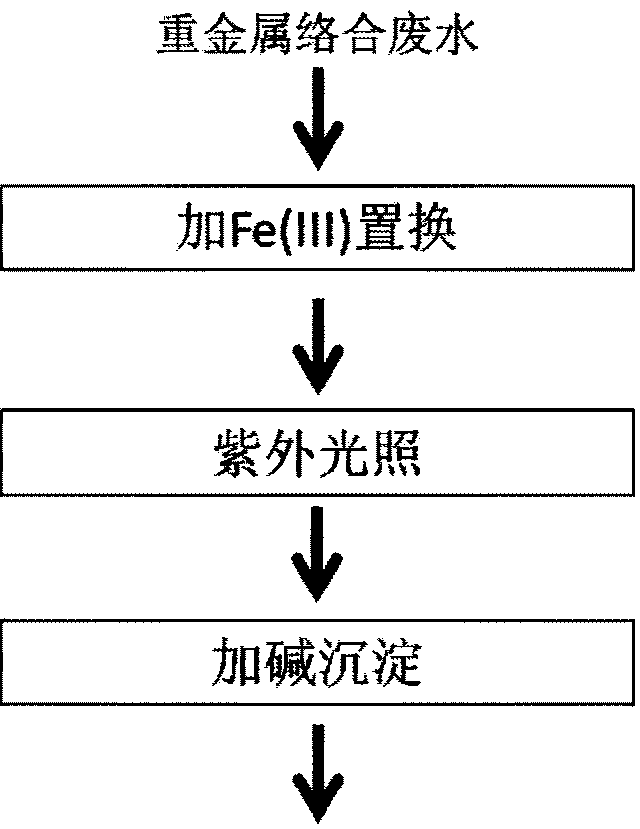A combined process for treating heavy metal complexing waste water
A combined process and heavy metal technology, which is applied in the fields of water/sewage multi-stage treatment, water/sludge/sewage treatment, water pollutants, etc., can solve the problems that the new process is difficult to take into account the economic and environmental friendliness, and the treatment effect is poor. , to achieve the effect of high utilization rate, high utilization rate, and reduction of TOC and COD values
- Summary
- Abstract
- Description
- Claims
- Application Information
AI Technical Summary
Problems solved by technology
Method used
Image
Examples
Embodiment 1
[0031] combine figure 1 , the copper concentration in the solution to be treated is 19.6mg / L, and contains excess citric acid.
[0032] Adopt a kind of combined process of processing heavy metal complex wastewater of the present invention to carry out wastewater treatment, its steps are:
[0033] Add ferric chloride according to the iron-copper molar ratio of 5:1, after mixing for 5 minutes, use a light intensity of 6mW / cm 2 Irradiate with a medium-pressure mercury lamp for 6 minutes, add calcium hydroxide to adjust the pH of the water to 9-10, and let it settle.
[0034] The remaining copper concentration in the final water body is about 0.4mg / L, the removal rate is about 98%, and the total organic carbon removal rate in water is 30-40%.
Embodiment 2
[0036] The copper concentration in the solution to be treated is 19.2 mg / L, and contains a slight excess of tartaric acid.
[0037] Adopt a kind of combined process of processing heavy metal complex wastewater of the present invention to carry out wastewater treatment, its steps are:
[0038] Add iron sulfate according to the iron-copper molar ratio of 6:1, after mixing for 10 minutes, use a light intensity of 6mW / cm 2 Irradiate with a medium-pressure mercury lamp for 8 minutes, add calcium oxide to adjust the pH of the water to 9-10, and let it settle.
[0039] The remaining copper concentration in the final water body is about 0.4mg / L, the removal rate is about 97.9%, and the total organic carbon removal rate in water is about 50%.
Embodiment 3
[0041] The copper concentration in the solution to be treated is 19.2mg / L, and contains slightly excess nitrilotriacetic acid.
[0042] Adopt a kind of combined process of processing heavy metal complex wastewater of the present invention to carry out wastewater treatment, its steps are:
[0043] Add ferric nitrate according to the iron-copper molar ratio of 6:1, mix for 10 minutes, and use a light intensity of 6mW / cm 2 Irradiate with a medium-pressure mercury lamp for 10 minutes, add sodium hydroxide to adjust the pH of the water to 9-10, and let it settle.
[0044] The remaining copper concentration in the final water body is about 0.7mg / L, the removal rate is about 96.4%, and the total organic carbon removal rate in water is about 30%.
PUM
 Login to View More
Login to View More Abstract
Description
Claims
Application Information
 Login to View More
Login to View More - R&D
- Intellectual Property
- Life Sciences
- Materials
- Tech Scout
- Unparalleled Data Quality
- Higher Quality Content
- 60% Fewer Hallucinations
Browse by: Latest US Patents, China's latest patents, Technical Efficacy Thesaurus, Application Domain, Technology Topic, Popular Technical Reports.
© 2025 PatSnap. All rights reserved.Legal|Privacy policy|Modern Slavery Act Transparency Statement|Sitemap|About US| Contact US: help@patsnap.com

